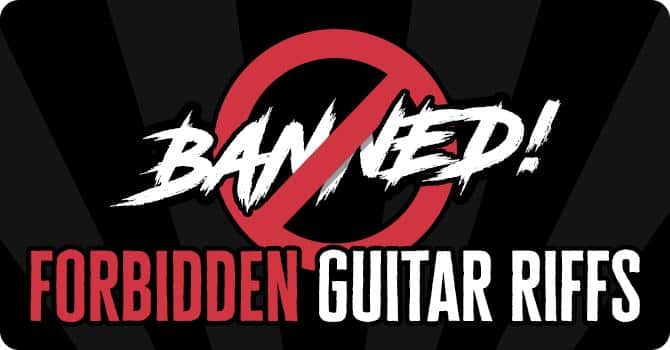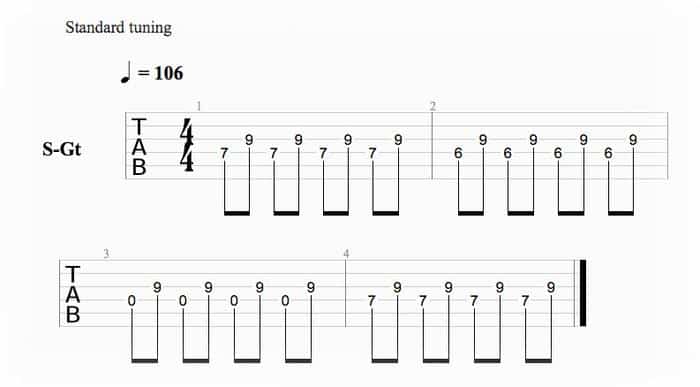Once in a small, bustling guitar store on the Sunset Strip, I stood witness to a remarkable transformation that involved only six strings and a captivating knowledge of guitar riffs—a transformation that is common among passionate musicians, yet painstakingly elusive to the untrained hand. To most, the buzzing, twanging, or wailing of an in-store guitar session is merely background music. But to us, these guitar store riffs are a secret language, whispering tales of musical prowess, individual style, and of course, music store etiquette.
It was in this very store, amidst an unplanned audience intrigued by the emotional effect of practiced finger movements, that I realized the immense power of a well-chosen riff, the kind which can leave the spectators in either awe or in an awkward grimace. The realization, however, left behind an unfinished story that beckons to be told: the tale of the good, the bad, and the absolute classic guitar store riffs—each unique in its cadences, revealing a musician’s soul, taste and capabilities. But, what does that perfect guitar riff sound like? And how do store etiquettes play a role in this symphony of strings?
While my journey through the corridors of Guitar Player has acquainted me with an array of riffs, it has also revealed an enigma: those very riffs which rain applause might also be the ones causing a cringe or two. This inexplicable musical realm, where notes rule and emotions run wild, shelters a world of good, bad, and classic riffs. Today, we’ll embark on a journey to uncover this realm, one cleverly fingered fret at a time.
That said, don’t fret about the unwritten rules—trust me, I know a thing or two about music store etiquette. As we dive into the depths of guitar store riffs, I promise to guide you along the twisting treble clef, strumming out a melody that appeals to both you, the musician, and the unsuspecting audience in that roomy guitar store. So tune up, plug in, and let’s get ready to riff!
Popular Riffs Played in Guitar Stores
Classic Guitar Riffs

In my over two decades serving Guitar Player, one can’t help but acknowledge how certain classic guitar riffs have become culturally synonymous with the guitar-playing experience. When stepping foot in any guitar store, you’ll surely hear the echo of these classic riffs, played with varying degrees of prowess by the store’s multitude of enthusiasts. These powerful introductions have shaped the course of guitar music history and continue to resonate through the hands of both beginners and veterans alike.
These best guitar intros, these classic riffs; they are not solely technical exercises, but testaments to the power of creativity and expression. They draw us in, create instant recognition, and often provide the heartbeat to songs we’ve adopted as anthems in our own deep personal journeys.
Pause for a moment and I’m sure you can hear the pulsating gallop of ‘Smoke on the Water’ by Deep Purple, the explosive power-chords of ‘Smells Like Teen Spirit’ by Nirvana, or the haunting slide guitar intro of ‘Scar Tissue’ by the Red Hot Chili Peppers. Each of these iconic riffs are a testament to the magnetic allure of the guitar, the profound impact few notes or chords can have, and the undeniable memory they can carve into the ears and minds of millions.
Regardless of one’s preference for genre or era, these classic riffs serve as the common vocabulary amongst guitarists worldwide. They provide a shared repertoire through which we can connect, compare talents, or flaunt individual style. So whether you’re watching a seasoned pro rip through ‘Back in Black’ by AC/DC, or a newbie furiously trying to master the intro of ‘Stairway to Heaven’ by Led Zeppelin, these riffs provide us all with that shared footprint in our musical journey. Classic riffs embody the heart of what we love about guitars, remaining an undying fixture within the soundtrack of our guitar store experiences.
As we continue to explore the world of ‘Guitar Store Riffs: The Good, The Bad and The Classic’, we’ll venture into the territory of iconic guitar licks and the infamous ‘forbidden’ riffs that still haunt many a store. Through these, we’ll reveal more about the talent and diversity of sounds that truly make playing guitar an art form.
Iconic Guitar Licks

On the journey from the popular to the classic, we stumble upon a niche but instrumental category; the heart of rock n roll, the pulsating keys to legendary performances – it’s the ‘iconic guitar licks’. These are the evergreen phrases that have not merely stood the test of time but are reborn in passing generations, revealing their slices of genius in variegated scales.
From my countless interviews with superstar guitarists and engaging interactions with seasoned store owners and patrons, I’ve gained a deep understanding of what makes a guitar lick iconic. Licks that resonate across generations are typically simple, melodic and driven by emotion. Yet they craft an indelible imprint, setting infinite stages ablaze with screeches of delight, bobbing heads, and Gyroscopic dance movements. Store guitarists are testament to their enduring charm, as they routinely reach out to these licks to test their mettle or display their prowess.
Iconic licks are not just a melody; they tell a story. Think about the opening notes of Jimi Hendrix’s “Purple Haze” or the haunting urgency of Deep Purple’s “Smoke on the Water”. They use repeated phrases, establishing a feeling of familiarity, making their tunes memorable. An iconic guitar lick can make fame easy, but can also lead to a lifetime of imitation, as we shall explore in the ‘Forbidden Riffs’ section.
Yet these immortal sequences continue to evolve. Take for example Derek and the Dominos’ “Layla”. What initially rocked as a visceral, high-octane riff, later morphed into an elegiac unplugged version, losing none of its poignancy. These iconic licks, they twist, they turn, yet remain timeless.
As we delve further into the rich tapestry of guitar licks, let us bear in mind that most legendary sequences started as mere experiments, and emerged to define genres. After all, the best tunes come from the heart, not just the fingertips.
As we tread ahead, let’s debunk the legend of the ‘forbidden riffs’, which has sparked many a myth in guitar stores and captured countless imaginations.
Infamous ‘Forbidden’ Riffs in Guitar Stores

What’s that distinct sound echoing from the back corner of the guitar store? Yes, that’s someone trying to impress with the opening chord progression from ‘Smoke on the Water’. While the riff is iconic and has its place in history, along with other infamous ‘forbidden’ riffs, they often entirely miss their mark in a guitar store. Played so frequently and, quite often, poorly, these riffs have become more cautionary symbols than musical feats in such an environment.
These riffs are ‘forbidden’ because they don’t actually showcase any real guitar playing finesse. Instead, they’re overused to the point where they’ve garnered an infamous reputation. They’re the riffs that when you hear them, you can’t help but roll your eyes and mutter, “Not again…”
At this point, you may be asking, “Well, what’s the harm in playing a little ‘Sweet Child o’ Mine’ or ‘Enter Sandman’? They’re classic riffs!” And yes, you’d be right. However, keep in mind that these are riffs that most, if not all, guitar store employees, and many customers, have heard played ad nauseam—often without the practiced skill that they truly call for.
Think playing ‘Stairway to Heaven’ in a guitar shop is a universal no-no? You’re not far off!
That’s right, tune into the collective groan that’s simmering under the surface when a customer starts strumming the opening chords of this legendary Led Zeppelin piece. As a seasoned observer and veteran guitarist, I can assure you, it’s not because we don’t love the song. It’s simply an etiquette thing; an appreciation for the guitar store staff who have heard it played, well, less than excellently. More times than they’d care to count.
Now, the question arises, “What should I play, then?” Herein lies the unspoken challenge. If you truly want to test a new guitar’s tones and capabilities, as well as potentially impress anyone within earshot (although that should never be your primary goal), you should be playing something more original, intricate or even improvisational. Using your own unique creations to test the tonal variety, balance, and resonance of an instrument is the key to understanding your compatibility with it.
Perhaps it’s time to retire these infamous ‘forbidden’ riffs, at least within the confines of a guitar store. Sure, play them when you’re sat around the campfire, or even as part of your band’s encore, but maybe hold off when you’re testing out your next potential six-stringed purchase.
This is not to demoralize or insult would-be guitarists, quite the opposite. It’s rather about enhancing your guitar-buying experience, playing something personally enriching, and—yes—respecting the often-jaded sensitivities of your fellow guitar store patrons. Master the art of navigating these subtle taboos, and trust me, your trips to the guitar store will be significantly more rewarding.
Proper Etiquette for Jamming in a Guitar Store
Testing Guitar Sound

After a lively exploration of jamming etiquette in a guitar store, let’s delve into the crucial step of testing guitar sound. With countless guitars under my fingertips, I’ve gathered practical tips on how to harness the true voice of each instrument.
How to test guitar sound lies at the very heart of this process. Properly plugging in the guitar is key. If you’re trying out an amplified guitar, ensure to use a quality cable and adjust the amp to a neutral setting. This allows the true sound of the guitar to emerge untainted. The next step is striking each string individually. Listen closely to gauge for any fret buzz or dead notes. Remember, every guitar has a unique sonic character, so play a variety of guitar testing songs to fully explore its range.
As part of your repertoire, choose songs that span multiple genres, from intricate fingerpicking folk to hard-hitting rock. In doing so, you map the guitar’s versatility and responsiveness. Listen to its sustain, pitch accuracy and tonal color. Are the low notes deep and rich? Do the high notes ring clear and bright? Testing a guitar sound is an intimate conversation between you and the instrument, and this dialogue reveals valuable insights.
From the heaviest riffs to the most delicate licks, every string should consistently deliver. Engagement is key here; don’t lean into the familiar comfort of always playing what you know well. Branch out, push boundaries, and you’ll find the right guitar will elevate your performance.
As we continue exploring ‘Guitar Store Riffs: The Good, The Bad and The Classic’, let’s move on to our next exciting step, crafting the perfect guitar try-out riffs. After all, selecting the right guitar is only the beginning of your musical journey.
Guitar Try-Out Riffs

As we navigate the exciting world of guitar shop etiquette, we’ve now arrived at a crucial stage, trying out guitars using some well-chosen riffs. Picking the ideal, insightful guitar try-out riffs isn’t about showcasing your skills but about assessing the instrument’s capabilities. Let me share some of the riffs I use when I’m jamming in a guitar store.
Commonly, I’ll start with a few well-known, yet simple, bass riffs. This gives me an initial feel for the guitar’s bass response, the heart of its tone. As I strum, I listen keenly for clarity, richness, and balance. If the bass notes seem ‘muddy’ or indistinct, it might indicate a lack of quality in the guitar’s construction or materials.
From there, I’ll progress to more complex, higher-register guitar try-out riffs. I’m not trying to wow anyone with my playing—I’m listening. I’m looking for any significant tonal shifts or inconsistencies as I move from one string or fret to another. It’s these minute details that can truly differentiate a quality instrument from a mediocre one.
Remember, selecting the perfect riff to demonstrate a guitar’s prowess is an art in and of itself. The key is to find riffs that test the breadth of the guitar’s capabilities, not merely ones that sound impressive.
Ultimately, though, the right guitar should feel like an extension of you. So, experiment with several guitar try-out riffs until you find the ones that speak to you and genuinely reveal an instrument’s character.
Ahead, we’ll dive more deeply into the process of testing a guitar’s sound, using both classic and contemporary riffs. We’ll look at what to listen for, and, importantly, how to do so respectfully in a guitar shop setting. Stay tuned!
FAQs
What is the guitar store Riffs?
What does Riffs offer in terms of good quality products?
Are there any bad or negative aspects to watch out for at Riffs?
What are Riffs’ classic goods to check out?
Conclusion
In the world of guitar, what you choose to play can say a lot about you. It’s a testament to your skills, musical taste, and even how much respect you have for the musical community. There you stand, guitar in hand, about to lay down a riff in the store. It’s a choice that comes with consequences. Can your riff selection reflect both your skills and respect for the music community? Let’s find out!
With my extensive experience in Guitar Player and beyond, I’ve come to understand how a simple guitar riff can form a bond among musicians. The guitar store riffs we explored, from the popular ones to the classic and infamous, are more than just notes played in succession. They’re a language, bridging gaps among diverse players.
And while freedom of expression is part of what makes playing guitar so great, it’s important that this doesn’t decline into haphazard strumming in a guitar store. Adhering to proper etiquette whilst jamming, trying out various guitar sounds, or testing those nifty guitar try-out riffs, not only speaks volumes about your prowess, but also your respect for the music community. After all, every note we strum, every riff we choose, resonates far beyond us; it reverberates in the entire store, and in the hearts of everyone who hears it.
To sum it up, enjoy your exploration into the world of guitar riffs, but let your journey go hand in hand with understanding and respect. Your choice of a simple guitar riff should reflect a symphony of your skills, musical respect, and love for the guitar community. After all is said and played, that’s how we strike the perfect chord.